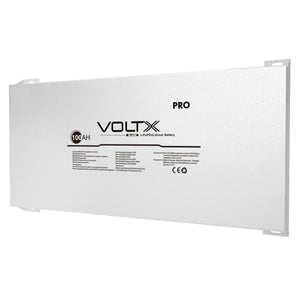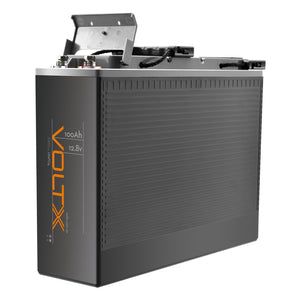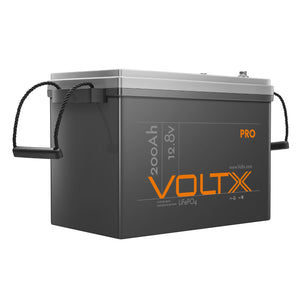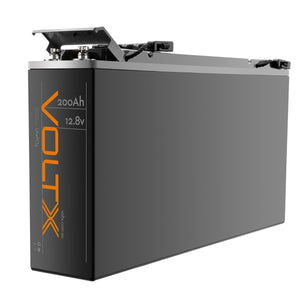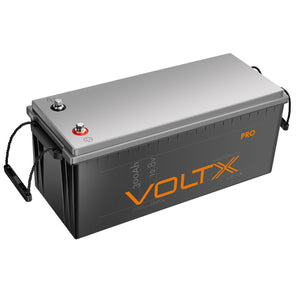12 Volt Batteries: A Comprehensive Overview
12-volt lithium batteries are ubiquitous in modern life, powering everything from cars and boats to RVs and off-grid solar systems. These versatile power sources come in various types, each with its own unique characteristics and applications. This article provides a comprehensive overview of 12-volt batteries, exploring their different types, applications, price ranges, lifespans, and maintenance requirements.
Applications of 12-Volt Batteries
12-volt batteries are used in a wide variety of applications, providing a reliable source of portable power wherever it's needed. Some common uses include:
- Automotive: 12-volt batteries are essential for starting the engines of cars, motorcycles, and ATVs. They also power various electrical components, such as lights, radios, and power windows.
- Marine: On boats, 12-volt batteries serve as starting batteries for engines and provide power for navigation systems, safety equipment, and other onboard electronics.
- Recreational Vehicles (RVs): In RVs and campervans, 12-volt batteries are crucial for powering appliances, lights, and entertainment systems, enabling comfortable off-grid living.
- Solar Power Systems: 12-volt batteries are integral to off-grid solar setups, storing the energy generated by solar panels during the day to provide power at night or during periods of low sunlight.
- Backup Power: 12-volt batteries are commonly used in backup power systems for homes, businesses, and medical facilities, ensuring continued operation of essential equipment during power outages.
- Golf Carts: Many electric golf carts rely on 12-volt batteries for propulsion.
- Portable Power: 12-volt batteries are also used in portable power solutions, such as those found in camping gear, small electronics, and other devices that require a compact and reliable power source. The versatility of 12-volt systems allows them to handle a wide range of power demands, from small lights to large engines.
Types of 12-Volt Batteries
There are two primary chemistries used in 12-volt batteries: lead-acid and lithium-ion. Lead acid batteries are the traditional type, while lithium-ion batteries are a newer technology with several advantages.
Lead-Acid Batteries
Lead-acid batteries are further categorised into several types:
- Flooded Lead-Acid Batteries: These batteries, often referred to as "wet cell" batteries, are the most common and affordable type of 12-volt battery. They consist of lead plates immersed in a liquid electrolyte solution of sulfuric acid. While flooded lead-acid batteries are a reliable and cost-effective option, they require regular maintenance, including checking and refilling the electrolyte with distilled water. They can also be affected by temperature changes, with extreme heat or cold potentially impacting their performance and lifespan. One important consideration with flooded lead-acid batteries is sulfation. Sulfation occurs when lead sulfate crystals build up on the battery plates, hindering the chemical reactions that produce electricity. This can happen if the battery is left in a partially charged state for extended periods. To prevent sulfation, it's essential to keep the battery fully charged and to use a battery maintainer if the battery is not used regularly.
- Sealed Valve-Regulated Lead-Acid (VRLA) Batteries: VRLA batteries are sealed and maintenance-free, eliminating the need for regular water checks. They are designed to handle moderate continuous current draw and are often used in applications where maintenance access is limited.
- Gel Batteries: Gel batteries are a type of VRLA battery that uses a gel-like electrolyte. This gel-like consistency makes them spill-proof and allows for installation in various orientations. Gel batteries are known for their low maintenance requirements and their ability to withstand high temperatures. However, they require specific charge controllers and slower charging cycles to avoid damage. The typical lifespan of a gel battery is 2 to 5 years.
- Absorbent Glass Mat (AGM) Batteries: AGM batteries are another type of VRLA battery where the electrolyte is absorbed in a fiberglass mat. This design makes them spill-proof, vibration-resistant, and capable of delivering high currents. AGM batteries are widely used in RVs, boats, motorcycles, and backup power systems due to their durability and maintenance-free operation. They also perform well in low temperatures. AGM batteries generally have a longer lifespan than flooded lead-acid batteries, typically ranging from 4 to 7 years.
Deep Cycle vs. Starting Batteries
It's important to distinguish between deep cycle and starting batteries since they differ a lot in terms of function. Starting batteries are designed to deliver short bursts of high current to start an engine. They have many thin lead plates to provide a large surface area for quick energy release. Deep cycle batteries, on the other hand, are designed to provide a steady current over a longer period. They have fewer, thicker lead plates that are less prone to overheating during prolonged discharge. Deep cycle batteries are commonly used in RVs, boats, and solar power systems where a continuous power supply is needed.
Lithium-Ion Batteries
Lithium-ion batteries are becoming increasingly popular due to their numerous advantages over lead-acid batteries. They offer:
- Higher Energy Density: Lithium-ion batteries can store more energy per unit of weight and volume compared to lead-acid batteries. This means they can be lighter and more compact while providing the same amount of power.
- Faster Charging: Lithium-ion batteries can be charged much faster than lead-acid batteries, reducing downtime and allowing for quicker recharging in various applications.
- Longer Lifespan: Lithium-ion batteries have a significantly longer lifespan than lead-acid batteries, often lasting 3 to 5 times longer. This translates to fewer replacements and lower costs over the long term.
- Deeper Discharge: Lithium-ion batteries can be discharged more deeply without damage, providing more usable capacity compared to lead-acid batteries, which can be damaged by excessive discharge.
- Maintenance-Free: Lithium-ion batteries do not require any maintenance, such as checking electrolyte levels or cleaning terminals, making them a convenient and hassle-free option.
Battery Management Systems (BMS)
Most lithium-ion batteries incorporate a Battery Management System (BMS). The BMS is an electronic system that monitors and controls the battery's operation, ensuring safety and optimal performance. It protects the battery from overcharging, over-discharging, and overheating, extending its lifespan and preventing potential hazards. The BMS also balances the charge levels of individual cells within the battery pack, further enhancing efficiency and longevity.
Charging Rates
Charging rates, often expressed as C-rates, indicate how quickly a battery can be charged or discharged relative to its capacity. For example, a 1C charge rate means the battery can be fully charged in one hour. Lead-acid batteries typically have lower charging rates, around 0.1C to 0.2C, while lithium-ion batteries can handle higher charging rates, often 0.5C or more. This faster charging capability is one of the key advantages of lithium-ion technology.
Cold Weather Performance
Temperature can significantly affect battery performance, especially in cold climates. Flooded lead-acid batteries are particularly susceptible to freezing in extremely cold temperatures, which can damage the battery. Gel batteries, on the other hand, tend to perform better in high temperatures but may experience reduced capacity in cold conditions. AGM batteries generally offer good performance in both hot and cold environments. Lithium-ion batteries, while generally more resilient to temperature extremes, can also be affected by cold weather. Some lithium-ion batteries have built-in heating systems to maintain optimal operating temperatures in cold climates.
Lithium Iron Phosphate (LiFePO4) Batteries
Within the lithium-ion category, Lithium Iron Phosphate (LiFePO4) batteries stand out as a superior option for demanding applications and outdoor enthusiasts. LiFePO4 batteries are a type of lithium-ion battery with several key advantages:
- Enhanced Safety: LiFePO4 batteries are inherently more stable than other lithium-ion chemistries, reducing the risk of fire or explosion. They have a higher thermal runaway temperature, meaning they are less likely to overheat and become unstable.
- Increased Lifespan: LiFePO4 batteries offer exceptional longevity, typically lasting 5 to 10 years or up to 4,000 charge cycles. This extended lifespan makes them a cost-effective choice in the long run, despite their higher upfront cost.
- Improved Performance: LiFePO4 batteries can deliver high power output and maintain a stable voltage throughout their discharge cycle. They are also less prone to capacity loss due to aging or deep discharges.
These advantages make LiFePO4 batteries ideal for use in RVs, boats, off-grid solar systems, and other applications where safety, reliability, and long-term performance are paramount.
Battery Sizes and Dimensions
12-volt batteries come in various sizes and dimensions to suit different applications. Battery group sizes are standardized classifications that indicate the battery's physical dimensions and terminal configurations. Some common group sizes include:
- Group 24: These batteries typically measure 10.25 inches long, 6.8125 inches wide, and 8.875 inches high. They are often used in RVs, boats, and smaller off-grid systems.
- Group 27: These batteries are slightly larger than Group 24 batteries, measuring around 12.0625 inches long, 6.8125 inches wide, and 8.875 inches high. They are commonly found in larger RVs and marine applications.
- Group 31: These batteries are even larger, measuring approximately 13 inches long, 6.8125 inches wide, and 9.4375 inches high. They are often used in heavy-duty applications and larger off-grid systems.
When choosing a 12-volt battery, it's essential to consider the available space and the required capacity to ensure proper fit and functionality.
Price Range of 12-Volt Batteries
The price of a 12-volt battery can vary significantly depending on the type, capacity, brand, and features.
| Battery Type | Price Range | Example Applications |
|---|---|---|
| Flooded Lead-Acid | $20 - $300+ | Car batteries, smaller RVs, engine starting |
| AGM | $100 - $500+ | RVs, boats, motorcycles, backup power |
| Gel | $150 - $400+ | RVs, boats, high-temperature applications |
| Lithium-ion | $100 - $2,000+ | RVs, solar power systems, portable power |
| LiFePO4 | $300 - $4,000+ | RVs, off-grid systems, demanding applications |
Lead-acid batteries are generally the most affordable option, with prices starting around $20 for smaller-capacity batteries and increasing with capacity and features. Lithium-ion batteries, particularly LiFePO4 batteries, tend to have a higher upfront cost but offer longer lifespans and reduced maintenance, potentially making them more cost-effective in the long run.
Lifespan of 12-Volt Batteries
The lifespan of a 12-volt battery depends on several factors, including the type of battery, usage patterns, charging practices, and environmental conditions.
Lead-acid batteries typically last 3 to 5 years in automotive applications. However, with proper maintenance and appropriate charging, their lifespan can be extended to 6 years or more. Frequent deep discharges, where the battery is discharged to a very low level, can significantly shorten the lifespan of lead-acid batteries. Conversely, infrequent use can also lead to sulfation and reduced battery life.
LiFePO4 batteries are renowned for their exceptional longevity, often lasting up to 4,000 charge cycles. This impressive lifespan makes them a reliable and long-term energy storage solution.
Maintaining a 12-Volt Battery
Proper maintenance can significantly extend the lifespan of a 12-volt battery. Here are some essential maintenance tips:
- Keep the battery clean: Regularly clean the battery terminals with a solution of baking soda and water to remove corrosion, which can impede the flow of electricity and shorten the battery's life.
- Maintain proper charge: Maintaining a 12V battery, whether it's lithium-ion, lithium iron phosphate (LiFePO₄), AGM, or another type, starts with proper charging practices. If the battery isn’t used regularly, use a battery maintainer to avoid deep discharge. For lithium-ion batteries, it’s best to store them at around 50% State of Charge (SOC). For LiFePO₄ batteries, aim for a SOC between 20% and 80% during storage to help preserve long-term battery health. SOC refers to how much energy is left in the battery, shown as a percentage of its total capacity.
- Refill flooded lead-acid batteries: Regularly check and refill the electrolyte in flooded lead-acid batteries with distilled water to maintain the proper fluid level.
- Avoid overcharging: Use a charger that automatically monitors charging levels to prevent overcharging, which can damage the battery and shorten its lifespan.
- Store the battery correctly: If storing the battery for an extended period, disconnect it from the vehicle and store it in a cool, dry place to minimise self-discharge and prevent damage.
- Test the battery's health: Periodically test the battery's voltage and overall health using a multimeter or a battery tester. This can help identify potential issues early on and ensure the battery is functioning correctly. A fully charged battery should have a voltage of around 12.6 volts. If the voltage is significantly lower, the battery may need to be recharged or replaced.
Conclusion
12-volt batteries are essential components in a wide range of applications, providing reliable power for our everyday needs. By understanding the different types of 12-volt batteries, their applications, price ranges, lifespans, and maintenance requirements, you can make informed decisions about selecting and caring for the right battery for your specific needs.
While lead-acid batteries remain a cost-effective option for many applications, lithium-ion batteries, particularly LiFePO4 batteries, offer significant advantages in terms of performance, lifespan, and safety. Their higher energy density, faster charging, longer lifespan, deeper discharge capability, and maintenance-free operation make them a worthwhile investment for demanding applications and outdoor enthusiasts.
When choosing a 12-volt battery, it's crucial to consider the specific requirements of your application, such as the required capacity, physical size constraints, operating environment, and budget. By carefully evaluating these factors, you can select a battery that provides reliable and long-lasting performance.
For those seeking the most advanced and reliable 12-volt battery technology, LiFePO4 batteries are a compelling option. Their enhanced safety, exceptional lifespan, and superior performance make them ideal for a wide range of applications, from powering RVs and boats to supporting off-grid solar systems and providing backup power.
Frequently Asked Questions
- What are the different types of 12v batteries available in Australia?
- How long can I expect a 12v battery to last?
- What is the best type of 12v battery for my caravan?
- How do I maintain a 12v battery properly?
- Can I use a 12v battery with my solar panels?

